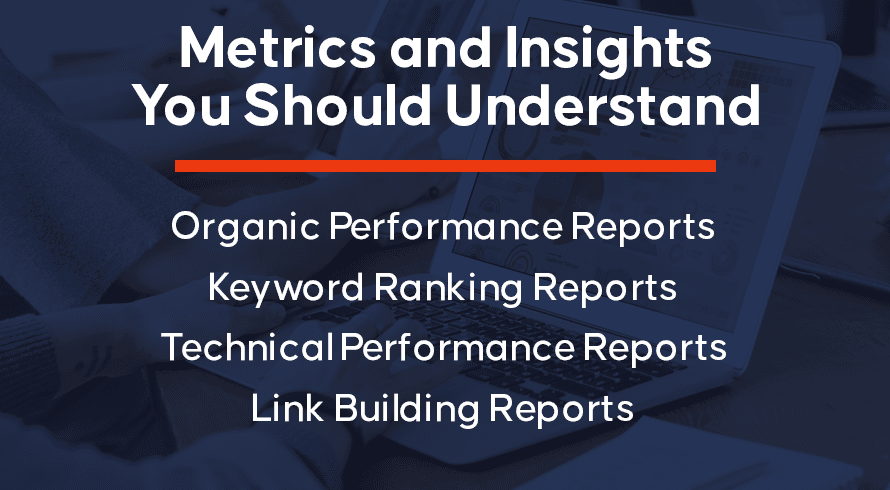Inquivix HQ
1-903, 18 Eonju-ro 146-gil,
Gangnam-gu, Seoul, Korea
06057

If you’re running a business, it’s important to make sure that your website is performing well on search engine results pages (SERPs). One way to measure how your website is doing is by generating an SEO report. In this report, you’ll find key metrics and insights that will help you understand how well your website is ranking and what you can do to improve your rankings. In this article, we’ll discuss the most important metrics and insights that should be included in an SEO report.
What Is SEO?
Search engine optimization is a process by which you can improve the ranking of your website on search engines. The higher your website’s rank, the more likely people are to find it. SEO involves improving the visibility of a website or web page in search engine results pages (SERPs). This process will help your company’s performance in the search engines.

SEO is important because it can help you attract more visitors to your website. Many people use search engines to find information, and if your website is ranked high on the results pages, you’re more likely to attract these people.
SEO can also help you improve the quality of your website’s traffic. When you attract visitors from search engines, they’re more likely to be interested in what you have to offer. This means that they’re more likely to convert into customers.
On-Page SEO
On-page SEO is the practice of optimizing a website’s content, structure, and associated coding to improve its visibility in search engine results pages (SERPs). On-page SEO is an important part of any effective SEO strategy, as it can help you rank higher in SERPs and attract more visitors to your site.
There are many on-page SEO techniques you can use to improve your site’s ranking and visibility. Some of the most important include optimizing your title tags and meta descriptions and adding keywords to your titles, headings, and body text.
Off-Page SEO
Off-page SEO refers to the techniques used outside of your website to improve your SEO ranking. This includes things like link building, social media marketing, and brand awareness. While on-page SEO is important, off-page SEO can be even more effective in helping you rank higher in search engine results pages. By focusing on quality backlinks and creating a strong social media presence, your website’s increased visibility can help you reach your SEO goals.
Technical SEO
Technical SEO is one of the most important aspects of SEO. It’s what makes your website search engine friendly and helps you rank higher in search results. There are many different factors that go into technical SEO, such as site structure and crawler access.
What Is an SEO Report?
Before we get into the specific metrics and insights, let’s take a quick overview of what an SEO report is. An SEO report is a document that contains information about how your website is performing in search engine results pages (SERPs). The report will include data on your website’s visibility, organic traffic, and keyword rankings.

SEO is a complex process, and there are many factors that you need to consider. However, by understanding the basics of SEO, you can start to improve the visibility of your website. In this article, we’ll provide an overview of the most important SEO metrics and insights that you should understand. We’ll also provide tips on how you can improve your website’s SEO performance.
SEO reports communicate to the relevant parties of the organization how well their SEO efforts are performing. The report is a comprehensive document that outlines all of the work that has been done on the website as well as what still needs to be completed. It can also include things like goals, objectives, and action items for future improvements.
Why Should You Produce a Regular SEO Report?
It’s important to have effective communication with your clients or team about the progress of your SEO efforts. Producing a regular SEO report is one way to do that. Your report should include any changes you’ve made to the website’s on-page optimization, off-page optimization, and link-building efforts.
You should also summarize your findings from any keyword research you’ve conducted and the updates needed to your keyword strategy. Finally, be sure to include any insights you’ve gleaned from your website’s analytics data. Producing a regular SEO report will help keep everyone on the same page and ensure that your SEO efforts are moving in the right direction.
Metrics and Insights You Should Understand
It’s critical to keep track of the metrics that are most important to your company if you run a website. If you don’t conduct any testing, you won’t know if your site is performing well or what adjustments you need to make in order to increase traffic and conversions. SEO reporting involves several key metrics that provide insight into your SEO performance.
Organic Performance Reports
These reports are useful in gaining insight into how organic traffic is performing on your website. Organic traffic is the term used to describe visitors who found your website through a non-paid method, such as natural search engine results or word of mouth. Reports can be broken down by country, landing page, and even keyword. This information can help you to identify which areas of your website need improvement and where you should focus your marketing efforts.
By looking at this data, you can see whether Organic traffic is increasing or decreasing and evaluate how successful your current SEO strategy is. If Organic traffic isn’t what you expected, then it might be time to rethink your approach and use the reports to make changes that will improve results. Keep in mind that these reports are only as good as the data that is available, so make sure to keep your website up-to-date with the latest changes to ensure accurate reporting.

Overall Visits
Overall visits to a website are the total number of website visits over a given period of time. This metric can be used to measure the website’s popularity, traffic, and reach. It is also a good indicator of how well the website is performing overall. Generally, the higher the number of overall visits, the more successful the website is. Seasonality might be discovered using overall traffic visit statistics by looking for any pattern in the website’s popularity.
Traffic Visits by Channel
Traffic from organic search (SEO) is the main source of visits for most websites. However, it’s important to track all marketing channels to see if any contribute significantly to website traffic. The number of visits from each marketing channel may be used to see whether other channels have any influence on SEO success.
All Traffic and Organic Traffic Goal Completions
Have your site’s visitors been fulfilling the objectives specified in the website analytics program? When comparing organic and non-organic goal completions, you may discover whether organic traffic is completing more or less than usual goal completions in comparison to other channels. This might help you evaluate whether SEO activities have a comparable impact as expected.
Page-Level Traffic
One of the most important aspects of a website is its page traffic. The more people who visit your website, the more potential customers you have. If you have new or updated pages, it’s best to check their performance. You can use Google Analytics to check your website’s page traffic. You’ll be able to see how many people visit each page, where they’re coming from, and how long they stay on the page. If you have a low amount of traffic on a particular page, it might be worth investigating why that is and making changes to improve things.
Organic Landing Page Sessions
The goal of this metric is to determine which pages are bringing the most organic traffic to your website. This is a valuable metric to track because it can help you determine which pages are the most popular with your audience and should be given more attention. You can use this information to improve the content of those pages, or even create landing pages specifically designed to drive traffic to your website. By tracking this metric, you can ensure that your efforts are being directed exactly where you want them to be.
Keyword Ranking Reports
As a business with an online presence, it’s important to be able to track your keyword ranking progress. Keyword ranking reports can help you do just that. By tracking your keywords, you’ll be able to see where you need improvement and make the necessary changes. Keyword ranking reports can help you determine which keywords are worth targeting and track your progress over time. This would tell you which of the keywords you are targeting are working and which ones you should consider targeting in the future. Keyword ranking reports can help your business stay ahead of the competition.
Technical Performance Reports
A website must be easily crawled and indexed in order for it to have good SEO performance. A website’s technical performance is one of the most important factors in SEO. In order to measure a website’s technical performance, you need to use certain metrics.
There are many different metrics that can be used to measure a website’s technical performance. The most important metrics are page load time, page size, and other data points. These metrics can help you identify problems with your website and fix them before they have a negative impact on your SEO performance.
Technical performance metrics are especially important for e-commerce websites. Slow page speeds can cause customers to abandon their shopping carts, which can lead to lost sales. By using metrics to track your website’s technical performance, you can ensure that your e-commerce website is running as efficiently as possible.
Server Response Codes
The true purpose of the technical performance report is to provide a clear picture of where the site’s issues lie. Audits should be conducted on a regular basis, ideally quarterly, to ensure that the pages in question are still not returning irrelevant response codes. This information is valuable because it might be beneficial to someone who receives the technical performance report.
Page Load Speed Times
You can see how well a website is loading over time by looking at its overall page load speeds. This will show you whether the website’s load speed is getting better or worse. Your website’s loading speed can affect visitor engagement immensely. If the pages take longer to load there’s a good chance that they might leave the site. You can use different tools to check your page’s speed.
There are many factors that affect page load time, such as image size and coding structure. However, optimizing images and compressing files can have the biggest impact on overall page speed. You’ll be able to see what’s causing the page to load slowly and how you can improve it.
Any Data That Shows a Need to Act
This is critical for you to note. If a problem on a site prevents it from being indexed, it’s essential that it be noted in the report. This might vary from report to report. Crawl data, site downtime, irreparable schema markup, and so on could all be metrics.
Link Building Reports
Link building is another crucial element of SEO. It is the process of acquiring backlinks to a website. The backlink profile is an important part of SEO and should be monitored regularly. The referring domains section shows the number of websites that are linking to your website. This information can help you determine which websites are sending traffic your way and whether or not you need to increase your link-building efforts. You can also use this data to find potential partners for reciprocal link exchanges.
URLs of Links Gained
This displays a list of links that you may have acquired throughout the reporting period. The list can be organized by the website’s domain name and should include the title of the article, the author, and the date it was published. The links can also be accompanied by a screenshot of how they appeared on your website. The URL to each link should be also included so you can quickly check them out.
Links Driving Traffic
Which links have resulted in an increase in the referral traffic, and how much traffic did they produce? Your link-building reports should have this data. This data shows which links are driving traffic to your website and how much traffic they are producing. Use this information to determine which links are worth investing in and focus on acquiring more links from these types of websites.
Conclusion
Now that you have a good understanding of the SEO metrics and insights from your website, it’s time to put this information to use. Your marketing teams can use these findings to prioritize their efforts and make decisions about where to allocate resources in order to improve their site’s search engine visibility.
Remember, SEO is an ever-evolving field, so it’s important to track your progress and revisit your analysis on a regular basis. Use the insights gleaned from this report as a starting point for continued optimization of your website’s search engine performance. That wraps up our look at the key SEO metrics and insights uncovered by our analysis of websites. We hope you found this information helpful! Be sure to revisit this guide and visit our website for your digital marketing requirements.
